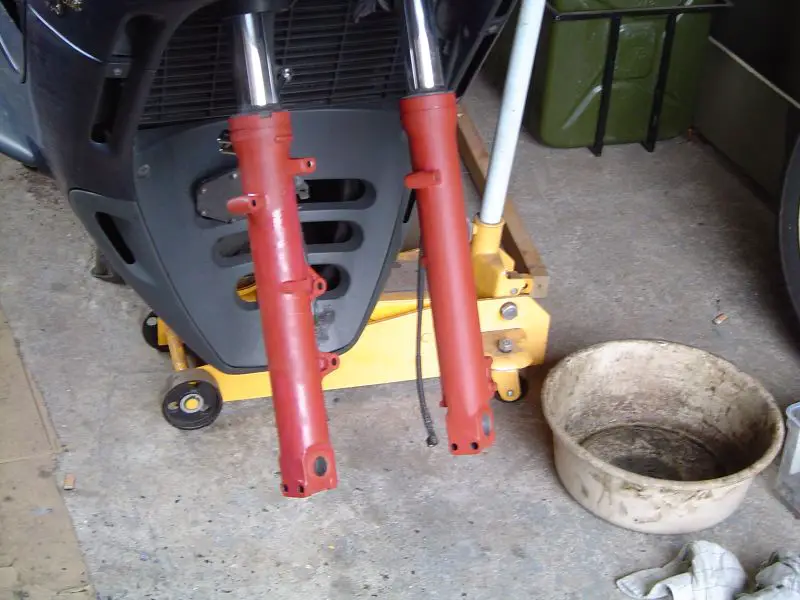My weekly routine inspection revealed that the front brakes needed some attention as the pads were getting near their wear limit. Generally the front pads last twice as long as the rear; it hadn't been that long ago that I put new rear pads in. Not a problem, I had some on a shelf.
Following the procedure in the workshop manual, I removed the pad retaining pin from the front right caliper and removed the old pads. I then repeated this on the left-hand caliper. Next step: push the pistons as far back into the caliper as possible using hand pressure only. Front right- done. Front left - hang on a minute, why aren't these pistons moving? Uh-oh.
I re-installed the old right-hand pads, and then cushioning the left-hand pistons with a block of wood, I tried using the front brake lever to force the pistons to move. No luck. I then tried pushing them in by using a G-clamp. No go. The pistons had seized solid.
Only one thing for it; remove the entire caliper from the bike so I can try freeing the pistons on the workbench. I removed the front wheel, then disconnected the banjo bolt attaching the brake hose to the caliper, and removed the caliper.
I decided whilst the caliper was off, to remove the right-hand caliper as well, and give the lower fork legs a coat of paint.
However, the fun started when I tried to remove the left-hand caliper bracket. The lower bolt came out without a problem. But as for the upper one...
After an hour or so I was still struggling to get the bolt undone. Galvanic corrosion had fused the steel bolt solidly to the aluminium. I'd have to drill it out.
An hour and several broken drill bits later, I now had a caliper bracket bolt with a hole in it.
It still refused to move. The only remaining option was to try and cut the bolt in half. I paused the sawing operation just before completion in order to take the second photo below.
Having finally got the caliper bracket off, I moved over to the workbench to get to work on removing the pistons. Forget about using compressed air to force these out; they were seized solid! The only option I had left was to use some vice-grips on them.
That got the pistons out of course, with a bit of a struggle; but they were no longer recognisable as pistons. Borrowing my wife's car I popped down to the local bike shop for a new set of pistons and seals.
Upon my return, I cleaned all the flaky old paint off the lower fork legs, gave them a coat of special metal primer, and then packed up for the day.
The following day I gave the fork legs two coats of black gloss.
On Monday, which was fortunately a Bank Holiday, I cleaned the caliper and installed the new pistons. I then reattached the caliper to the bike, this time using plenty of copper grease on the bolt threads. Some purists say you should not use copper grease on a steel bolt in an aluminium housing - well it was all I had available and in my view it was better than not using anything. Besides, having drilled the old bolt out, there was no longer any thread left in the aluminium housing, so I used a nyloc nut on the end of the new bolt.
The new pads were then installed and I bled the brakes.
I always use EBC brake pads - I used this brand on the Yamaha without problems, so I use them on the Pan as well. I tend to keep a set on hand; as soon as they've been used I get another lot. I've found the best place to buy pads is direct from EBC.
Since the front caliper incident, whenever washing the bike, I always pay particular attention to the exposed portion of the pistons, and wipe around them with a rag containing a few drops of brake fluid. I've also got a spare set of pistons and seals on the shelf.
Galvanic corrosion is a particular problem in the UK, where in the winter the roads are gritted with salt.
Whilst on the subject of corrosion:
TIP:
Once a month, crack open the clutch fluid and brake fluid cover screws half a turn and re-tighten. If you don't regularly loosen and re-tighten them, they won't move ever again, leaving you no option but to try to drill them out. Soon after this point your special unbreakable tungsten-titanium-steel-hardest-metal-known-to-man (did I mention 'unbreakable'?) screw extractor will break off in the hole, leaving you no option but to buy a complete new brake fluid reservoir. Don't ask me how I know...



